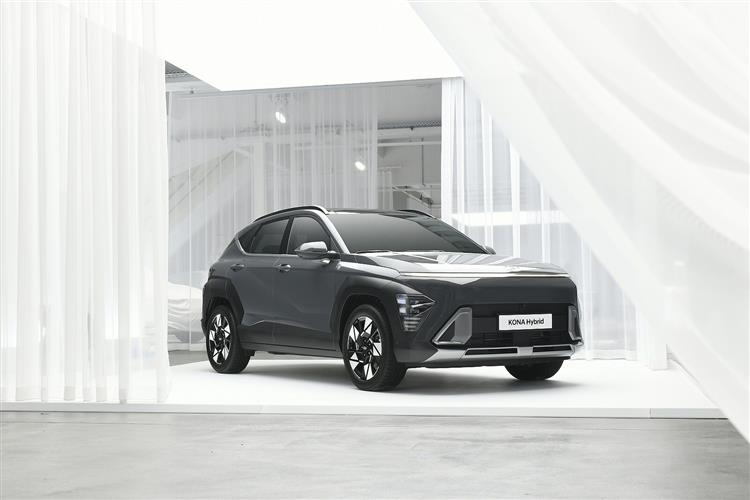A BETTER TRAFFIC KONE? (some text hidden) --NONE--
By Jonathan Crouch
Hyundai's Kona Hybrid gains a more sophisticated vibe in second generation guise but the engineering's much as before. Jonathan Crouch takes a look.
Ten Second Reviewword count: 63
A little surprisingly, there still aren't many full-Hybrid small SUV crossovers on the market - just conventional models, mild hybrids and full-electric contenders. But Hyundai, borrowing the engineering first seen in the Kia Niro, has carved out a useful niche for itself with this Kona Hybrid model. Here's the second generation version, which offers more space, greater sophistication and smarter looks. Sounds promising.
Backgroundword count: 211
The Kona small SUV, named after the island of Hawaii's Kona district, has proved to be one of Hyundai's strongest-selling models. It was first launched in 2017 with a range of petrol and diesel engines, then a full-electric battery-powered EV version joined the range in 2018. A year later, the CRDi diesel powerplants in the line-up were replaced by the far more eco-conscious Kona Hybrid. That car was facelifted in 2021. And the second generation version we're going to look at here (also offered in mild hybrid and full-EV forms) arrived in mid-2023. Now you're up to date. We ought to clarify the terminology here. 'Hybrid' is a word bandied about quite a bit these days, but very often at present, it designates 'mild hybrid' technology, the sort of thing you get in this class for instance in a Ford Puma, which sees a normal combustion engine only very marginally electrified by a tiny battery positioned under the rear seat. Full-Hybrid engines are very different and, unlike mild hybrids, can switch to full-electrification in city motoring. Toyota's C-HR, Renault's Captur, Honda's HR-V, Toyota's C-HR and Yaris Cross models and this Kona close cousin, the Kia Niro are the only other models currently offering such a thing in the small SUV segment.
Driving Experienceword count: 346
The Kona Hybrid takes its drivetrain from the proven Kia Niro Hybrid, using a Kappa 1.6 GDi Atkinson Cycle combustion engine working with a 1.32kWh battery and a 60PS motor to deliver a maximum hybrid system power of 141PS and 265Nm to the front wheels, which (apart from the slightly smaller battery size) is the same as before, as is the 6 speed dual clutch transmission. That torque output isn't quite as much as would be generated by a comparable diesel SUV of this size, but it's not too far off. This model's little electric motor can only power the car for very short periods - you'll need the kind of Plug-in Hybrid powerplant Hyundai doesn't offer in the Kona if you want an engine package with longer EV range. Instead, this Hybrid unit's main role is to cut in and out and improve frugality during urban driving. As for performance, well 62mph from rest takes 11.2s en route to a 103mph maximum in the 'Sport' setting (or 96mph in 'Eco' mode). If you're familiar with the previous generation version of this model, you can expect a big refinement improvement thanks to the sleek aerodynamics and lessons Hyundai says it's learned from the slippery IONIQ 6. This Hybrid Kona model takes its more sophisticated multi-link rear suspension from the top variant in the petrol Kona range, the 1.6T 198PS derivative. And it can offer a towing capacity of up to 1300kg. On the move, you notice a somewhat rough, coarse note to the GDI petrol engine under harsh acceleration - it's one of Hyundai's older units. But lift off and refinement reigns supreme, perfectly complementing the light but accurate 'Motor Driven Power Steering' system that makes the car so easy to precisely place on the road, whether you're in town or threading your way at speed through corners on the open road. To improve traction and damping through those bends, there's also an 'Advanced Traction Cornering Control' package. Plus there's the aforementioned 'Sport' mode to sharpen throttle response and give the steering a little more weight.
To see the full road test text contact us on 0330 0020 227
Pictures (high res disabled)

.jpg)
|
.jpg)
|

|
Statistics (subset of data only)
Min |
Max |
|
Price: |
£29,795.00 (At 12 May 2023) |
£33,995.00 (At 12 May 2023) |
CO2 (g/km): |
101 |
117 |
Max Speed (mph): |
103 |
|
0-62 mph (s): |
11.2 |
|
Combined Mpg: |
50 (est) |
|
Length (mm): |
4355 |
|
Height (mm): |
1825 |
|
Boot Capacity (l): |
466 |
|
Scoring (subset of scores)
Category: Hybrid, Plug-in, Electric & Hydrogen
| Performance | |
| Handling | |
| Comfort | |
| Space | |
| Styling, Build, Value, Equipment, Depreciation, Handling, Insurance and Total scores are available with our full data feed. | |



